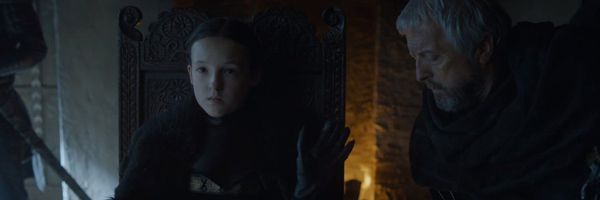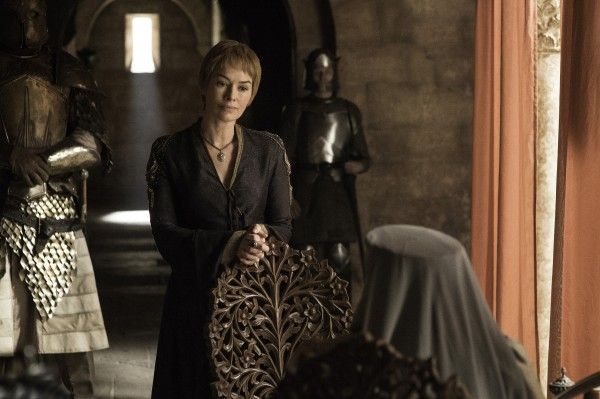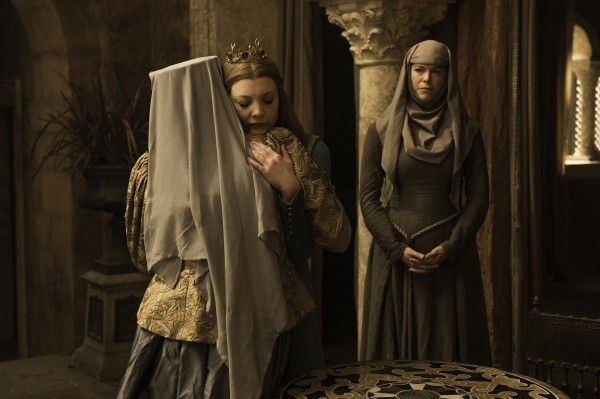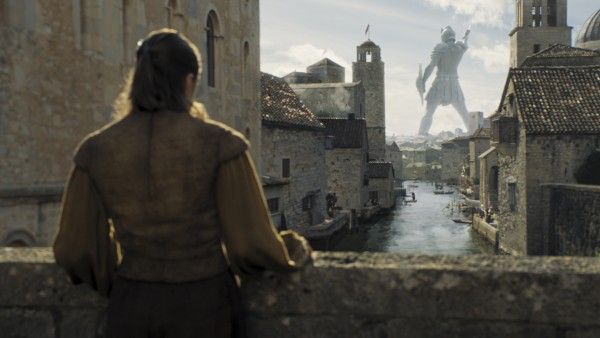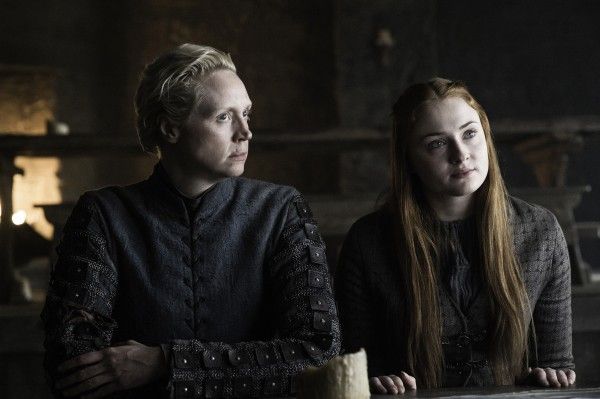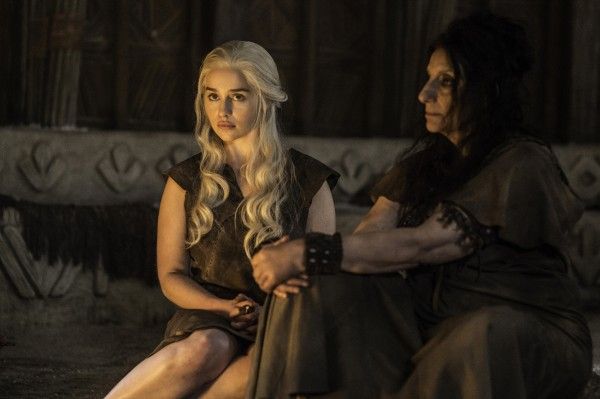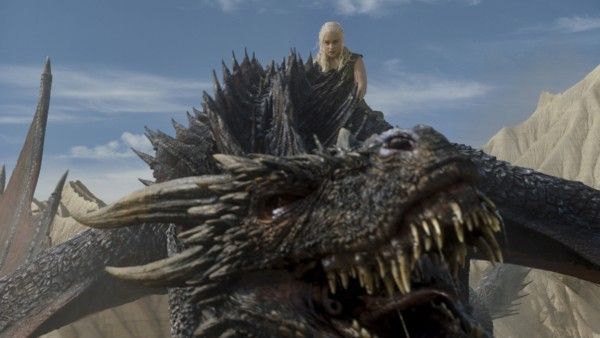As soon as fierce, tiny Lady Lyanna Mormont took the screen on this week’s Game of Thrones, the Internet started campaigning for her rule of the Seven Kingdoms. That’s the way Season 6 of this much-beloved fantasy drama adaptation has been going: After five seasons of watching girls and women too often sequestered to roles of passivity, the female characters on this show are getting to act as agents of plot in some pretty cool ways that could spell the end of the patriarchal order that more-or-less currently rules Westeros, the wildlings, and the White Walkers.
From newly-introduced, mini-badasses like Lyanna Mormont to veteran players like Brienne of Tarth or Olenna Tyrell, women are acting rather than reacting to plot more frequently and in greater numbers than ever previously done on this show. Across the kingdom, on all points on the hero-villain spectrum, Game of Thrones Season 6 is smashing the patriarchy and having women take the lead. We’ve outlined how, why, and what it could mean for the endgame of this show…
Passing the Bechdel Test with flying colors.
If you’ve never heard of the Bechdel Test, it’s a simple metric applied to film and TV shows to determine if said work of art is doing the bare minimum when it comes to female representation. The test is this: At any point in the film or episode, are there two women talking to each other about something other than a man? That’s it. That’s the whole test, and you’d be shocked at how many TV shows and movies can’t manage to do even that when it comes to crafting a story.
The Bechdel Test calls attention not only to the general lack of female representation in mainstream media, but also to the lack of representation when it comes to female relationships in mainstream media. If there happens to be more than one female character, they often don’t get to interact or — if they do — their relationship is defined by their respective relationships to the male characters. In other words: their very existences revolve around the men in their lives. Why would they have any reason to interact if not to discuss the men they know?
Game of Thrones Season 6 has gotten a lot of much-deserved attention for the prominence of female characters in its plotlines, but the Season 6 element that keeps standing out to me is the degree to which we get multiple female characters interacting in diverse ways. For example, in “The Broken Man,” this week’s episode, we got granddaughter Margaery and grandmother Olenna more or less expressing their devotion to one another, as another female character (evil septa Unella) looked on. We got Sansa and Lyanna Mormont, respective leaders of their houses, briefly discussing the burdens of leadership and of Lady Mormont’s namesake, Lyanna Stark. We got Olenna and Cersei, those two pillars of Game of Thrones’ female agency, admitting temporary defeat in the wake of Cersei’s over-machinations. And we got Yara outlining her planned alliance with Daenerys while casually flaunting her non-heteronormative sexuality.
But this theme of female agency and power isn’t isolated to “The Broken Man.” Elsewhere in the season, we have seen Brienne pledge herself to Sansa, a powerful alliance that has led to Sansa calling Littlefinger out and challenging Jon’s rule. We have seen the conflict between A Girl With No Name and the House of Black and White mainly carried out through Arya and The Waif. We have seen Meera fight off wights, kill a White Walker, and carry Bran across the frozen tundra of beyond The Wall, saving his life (and, perhaps, the lives of all of the living) many times over. And, of course, we have seen Daenerys slay entire temples of khals, convince Dothraki to board ships, and ride dragons. These are just the highlights. In seven episodes, we have more examples of female agency then we can comfortably list here.
Why this season has felt more heroic, more vengeful.
Why the feminist Season 6? Sure, it could just be good writing — because including a more diverse, fully-realized cast of characters tends to equal good writing — but it could also be a thematic turning of the tide for Game of Thrones. It’s not too much of a stretch to call Season 6 the least depressing season of Game of Thrones thus far. Sure, Ramsay Bolton is still breathing, but, more than ever, characters who have been wronged are getting a chance for vengeance — even if that vengeance, as is the case with Brynden “Blackfish” Tully, seems to be the choice to die in the castle you were born in.
As the show moves towards its inevitable end point, it is starting to bring characters back together and, more generally, to start wrapping storylines up that have been building since Season 1. More often than not, this means that the characters who have been left standing in the midst of loss, sacrifice, and suffering are starting to seek vengeance for all of the agony they have had to endure for five seasons.
I’m not saying that Game of Thrones is going to be all puppies and rainbows from here on out — Game of Thrones will never be that show that ties everything up in a nice, neat bow and a double marriage — but, if you believe in a story arc, there’s only one way you can go with characters once you’ve hit rock bottom. And so many of these characters, so many of these women, have hit rock bottom. Margaery, Cersei, Sansa, Meera, Arya, Yara, etc. have been brought to their knees to varying degrees, have seen their loved ones murdered in front of them and had their bodies and minds violated. Season 6 has seen these same female characters’ slow, steady rise from that abyss, a narrative pattern also gives us some clues about how Season 6 might wrap up...
What this feminist streak could mean for the endgame of this show.
What might this feminist theme tell us about the end of this season and, eventually, the end of this show? Well, in the short term, it certainly hints at the possible introduction of Lady Stoneheart, aka the revived corpse of Catelyn Stark intent on seeking vengeance for the wrongs done against herself and her family. Cat got a mention in “The Broken Man,” as did the Brotherhood Without Banners (in the books, Brotherhood leader Beric Dondarrion sacrificed his undead life for Catelyn’s). Could Lady Stoneheart rise out of The Trident and complicate the Riverrun siege? It would certainly be in theme with much of what’s happened in Season 6.
What could this Rise of Women theme mean for King’s Landing? Well, it certainly doesn’t spell a happy ending for the High Sparrow. With both Margaery and Cersei out to get him, the religious man doesn’t really stand a chance, does he? The more interesting question is: Might Cersei and Margaery work together to take him down? Though there has been no hint at the two women joining forces — and they historically hate one another — there’s nothing like a common enemy to bond two slightly-lesser enemies together. Regardless, the speculation that Cersei may burn down King’s Landing at the end of the season isn’t so hard to imagine, especially within the context of this feminist theme.
Perhaps the larger question is: will this theme continue through the rest of the show and does it have some larger meaning within the context of the game of thrones and the war against the dead? If the answer to both questions is “yes,” then Daenerys seems a safe bet for the Iron Throne, with characters like Yara Greyjoy, Sansa Stark, Margaery Tyrell, Lyanna Mormont, and even the Sand Snakes (of the dreaded Dorne subplot) ruling over their respective kingdoms and houses when the time comes to face the undead army.
Could Game of Thrones have been building towards a female-ruled land of the living this entire time? In many ways, it works thematically with what we know of the White Walkers who, up to this point, have been depicted entirely as male. (Though, in the books, the Night’s Queen is rumored to play a role in the kingdom of the dead.) When we first glimpse the White Walkers, it is through Craster’s tradition of sacrificing his male sons to the White Walkers. Is there something more than the affirmation of lazy, male-centric storytelling at work here? Could Game of Thrones have been building towards the dismantling of the Seven Kingdoms patriarchy and the dudely threat of the White Walkers this whole time? For a show that began its current season with an end-of-episode twist centered around an old woman taking off a necklace and exposing her true, wrinkly self, why not?

